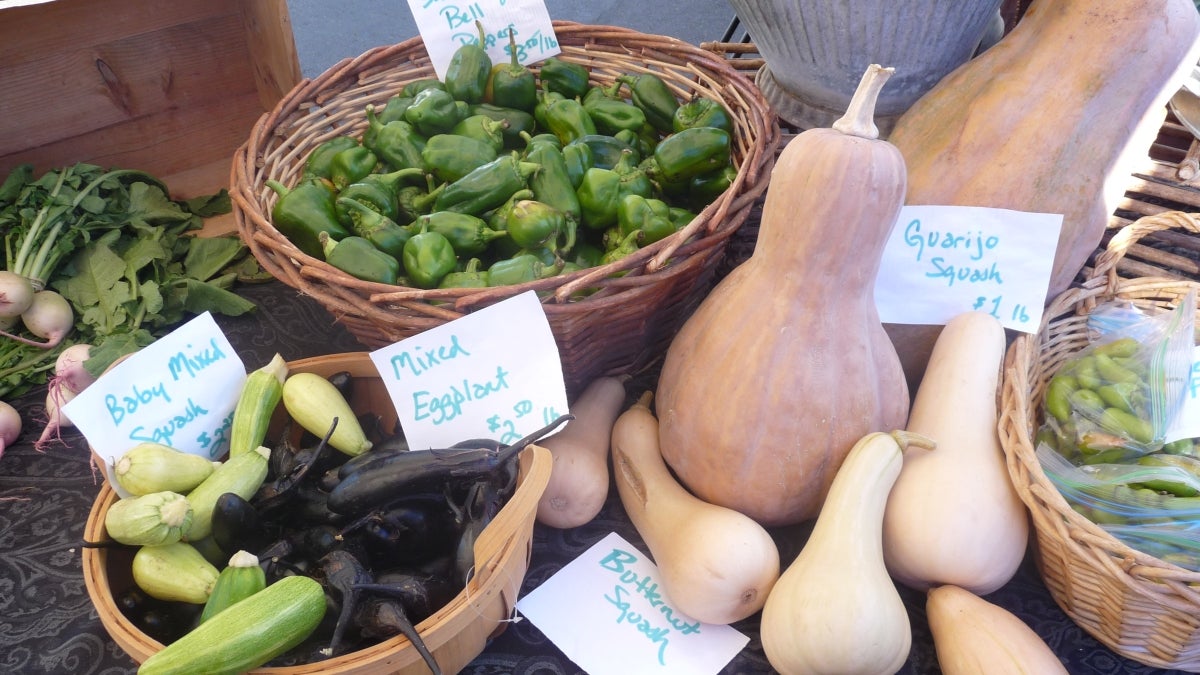Local foods get more accessible

Want to stock up on the freshest fruits and vegetables, grass-fed beef, and holiday cooking ingredients such as pumpkins and pecans? Look no further than your local farmers market.
Farmers markets have been steadily gaining popularity in Arizona. Today, about 75 different markets exist across the state, with more than 20 in the Valley area alone. For the 1.1 million Arizonans who rely on the government’s Supplemental Nutrition Assistance Program (SNAP), being able to use their benefits at local farmers markets is something to be thankful for.
Christopher Wharton, an assistant professor in ASU’s School of Nutrition and Health Promotion, received a grant from the U.S. Department of Agriculture (USDA) in 2009 to increase accessibility to farmers markets in Arizona. In the past year, the USDA has awarded more than $14 million in grants to people and organizations across the U.S. in an ongoing effort to connect local farmers directly with consumers.
Households that participate in SNAP are given Electronic Benefit Transfer (EBT) cards, similar to debit cards. These can be used to buy food items and are accepted at most grocery stores and some farmers markets. Wharton identified eight farmers markets in Arizona that did not have EBT technology, and implemented wireless terminals that could accept both EBT and regular credit and debit cards. He tracked sales at five of those markets for a period of 10 months, two years in a row. Wharton is now analyzing the data, and has seen a trend in sales increasing.
“What we found was EBT sales went up. We expected that because it was zero before, but we also see that overall sales actually jumped at four of five markets and increased beyond the EBT sales alone,” Wharton says. The increase in overall sales may have occurred because of the newly added convenience of being able to pay for things with a debit or credit card.
Individuals in Arizona that qualify for SNAP receive an average of $29 per week or $4.18 per day. The program is meant to cover about 70 percent of a person’s dietary needs, although many people rely on SNAP to pay for all of their food. With such a tight budget, it can be difficult to plan healthy, affordable meals. Lower income people also tend to live in areas with limited access to fresh fruits and vegetables.
“In urban areas, fruits and vegetables oftentimes are more expensive because they’re being sold out of corner markets rather than larger grocery stores. Grocery stores benefit from economies of scale – they sell to a lot of people, so they can sell things at lower prices. Corner markets can’t do that,” Wharton says.
Various studies show that prices at farmers markets are comparable to prices at grocery stores. Wharton’s data shows that, once they had the option, EBT participants did choose to spend a percentage of their benefits at local farmers markets. One market that received the wireless terminals saw EBT sales of about $500 over 10 weeks – a huge improvement over no EBT sales at all.
Another benefit of farmers markets is what they don’t offer – heavily processed “junk food” or sugary drinks. Despite overwhelming scientific evidence linking foods high in fat and sugar with obesity, a portion of SNAP benefits every year is spent on these types of foods because they are inexpensive and easily accessible.
“You don’t have vendors selling sugary beverages like sodas and things at farmers markets. Instead, you have the farmer there selling squash and tomatoes and things like that. You’re getting the healthiest foods available – whole, local fruits and vegetables – into people’s diets if they’re shopping at farmers markets,” Wharton says.
Additionally, supporting local farmers markets makes them more financially viable for small and midsized farmers who may be struggling. At grocery stores, farmers receive about 20 percent of the profit made from their goods, while they can keep 50 to 100 percent of the profit at farmers markets.
Communities all over the country are participating in the local foods movement, including ASU’s Tempe campus, which hosts a farmers market every other Tuesday throughout the school year. Wharton says college campuses are the perfect setting to engage a large population in the idea of buying and eating locally.
“It’s a perfect place to educate people about food. It’s nice because you can utilize the resources of the university, and have access to a campus where there’s lots of traffic.”
Wharton also co-founded Chow Locally, an online marketplace where consumers can purchase items directly from local Phoenix area farmers.
You can source local ingredients for your holiday dishes through this searchable database of local farms. Or visit this list of all Arizona farmers markets.
Written by Allie Nicodemo, Office of Knowledge Enterprise Development.